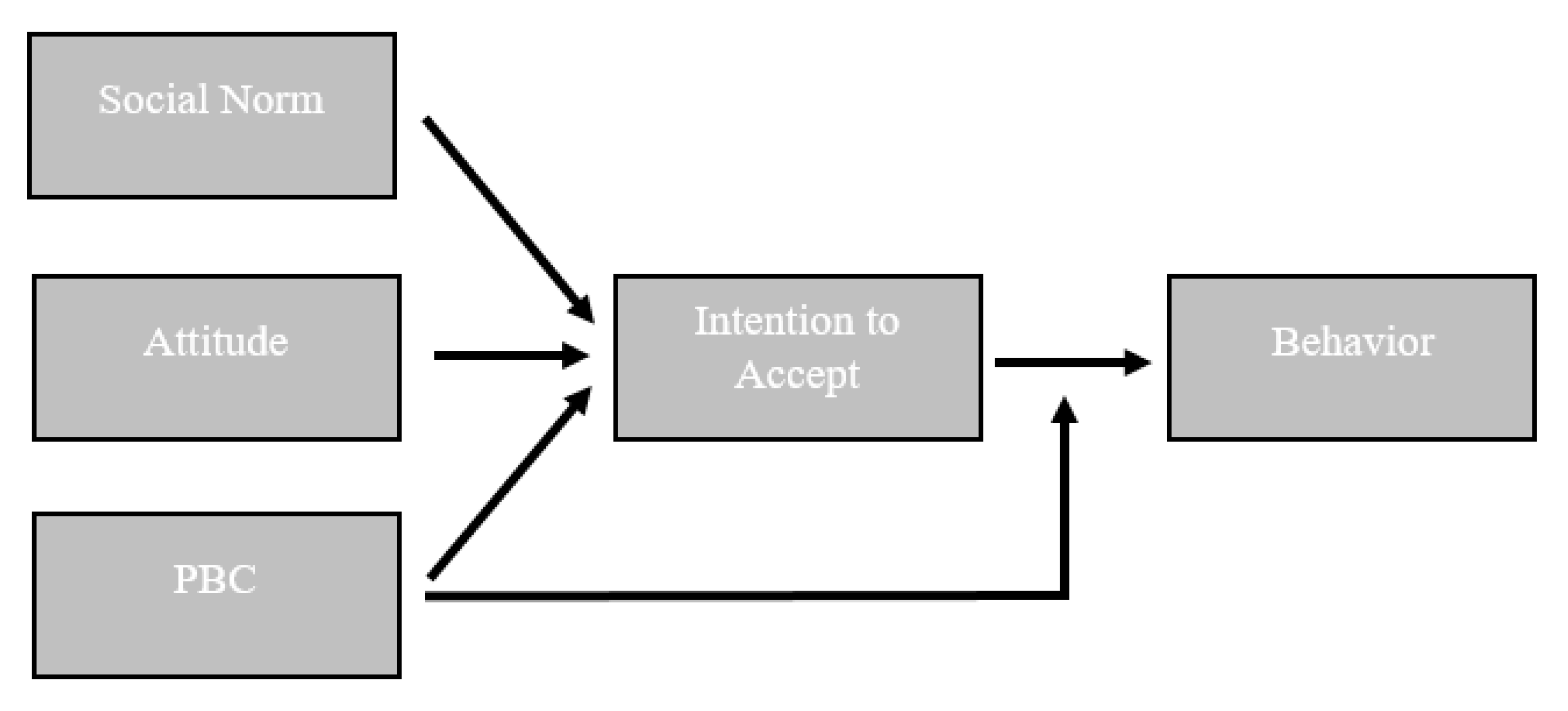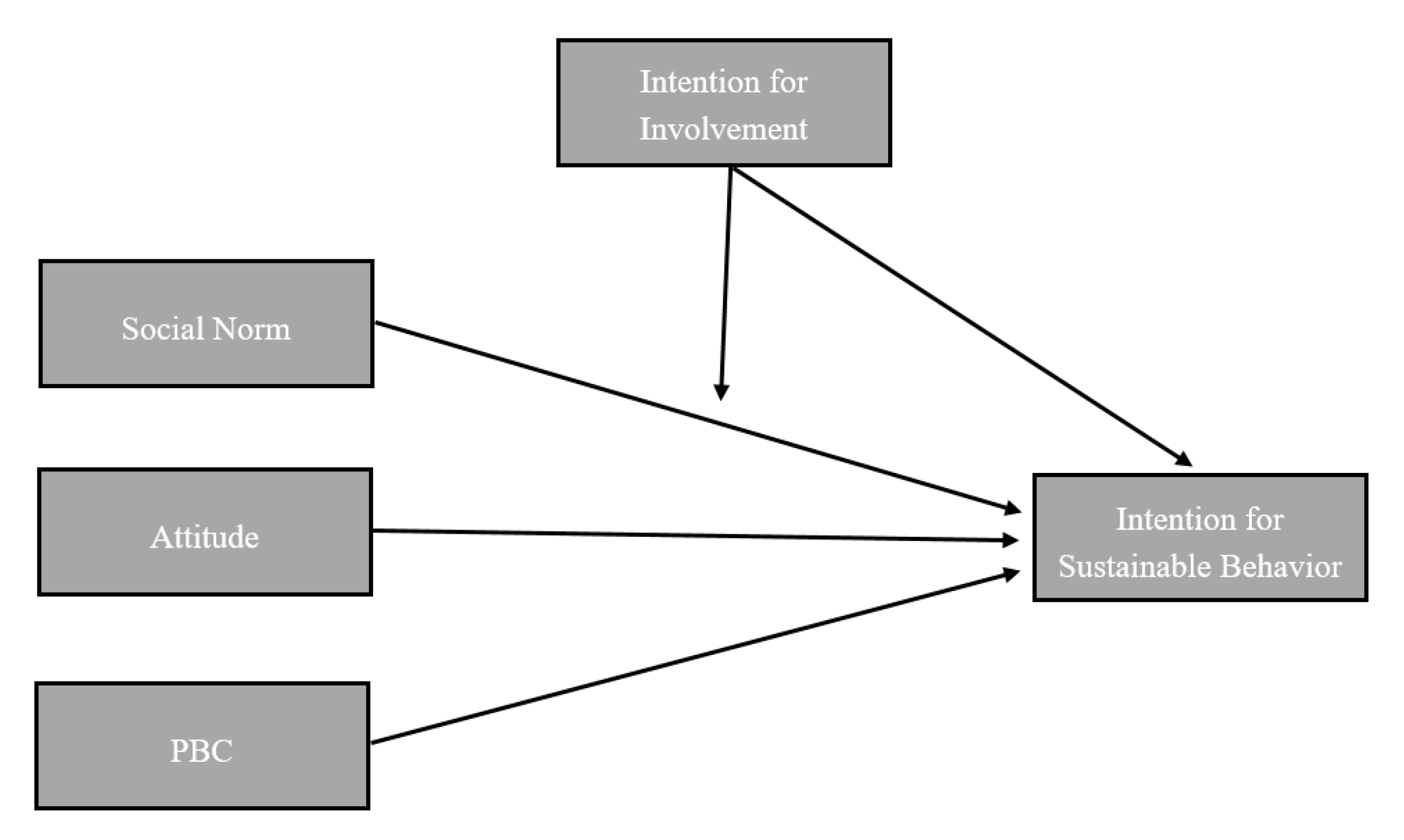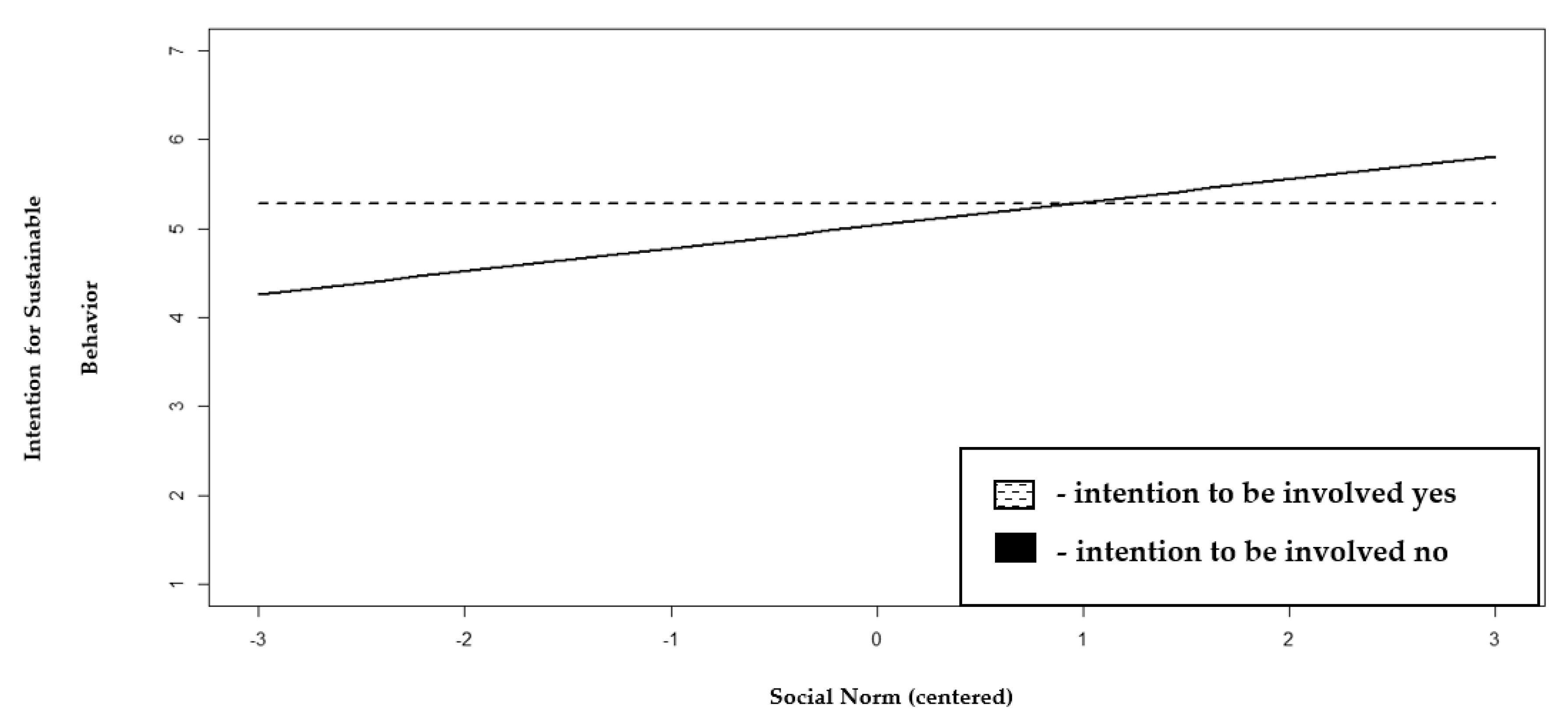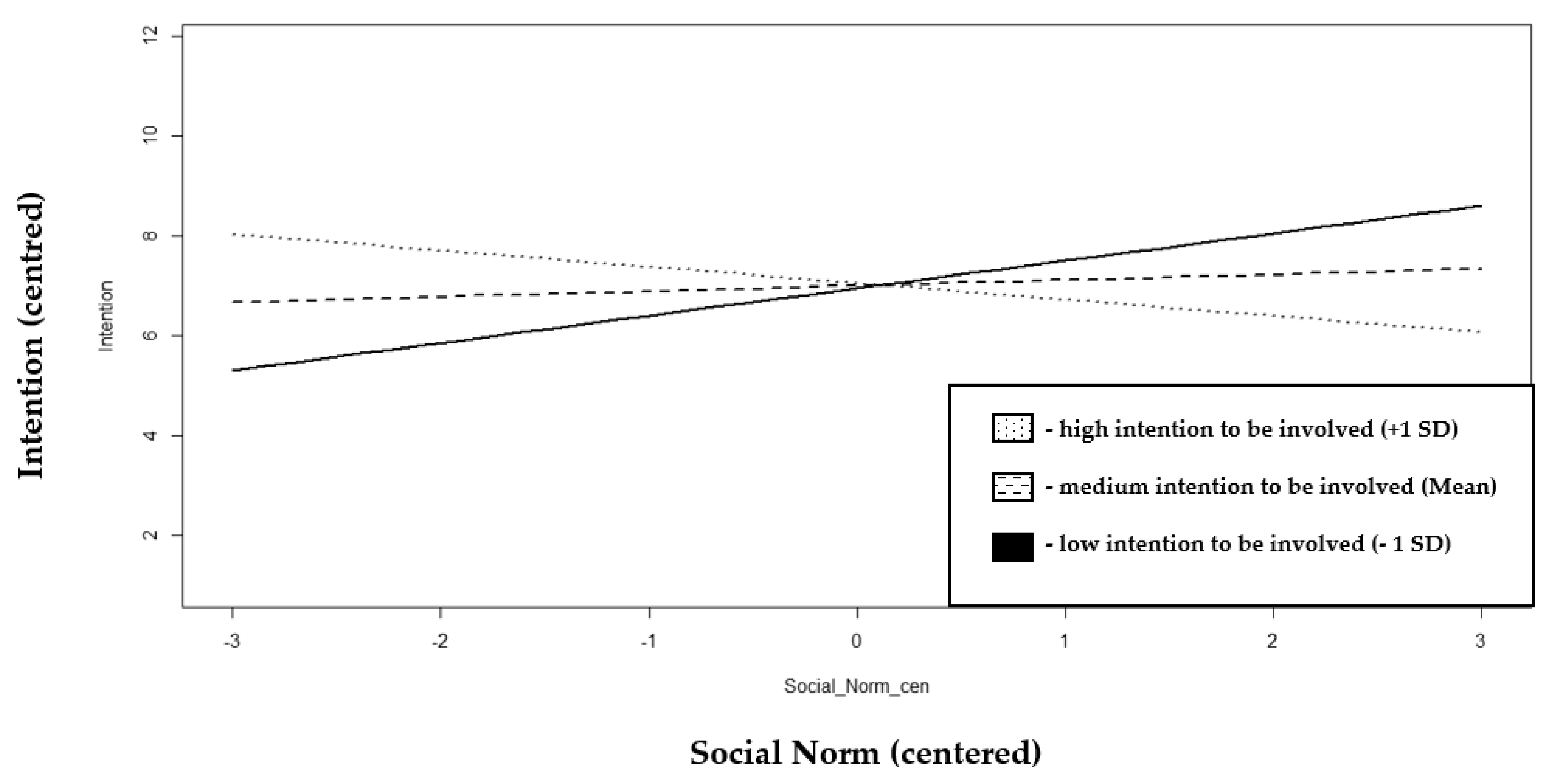Target-Oriented Promotion of the Intention for Sustainable Behavior with Social Norms
Abstract
1. Introduction
2. Theory
2.1. Theory of Planned Behavior
2.2. The Literature on Social Norms
3. Study 1
3.1. Sample
3.2. Instruments
3.3. Results from Study 1
3.4. Discussion of Study 1
4. Study 2
4.1. Sample
4.2. Instruments
4.3. Results from Study 2
4.4. Discussion of Study 2
5. General Discussion
6. Conclusions
Author Contributions
Funding
Conflicts of Interest
Appendix A
| Variable | Item | Scale |
|---|---|---|
| Intention for sustainable behavior | I intend to behave in a more energy-saving manner at the university in the future. | 1—do not agree at all to 6—completely agree |
| Intention for sustainable behavior | I intend to behave in a more resource-saving manner at the university in the future. | 1—do not agree at all to 6—completely agree |
| Intention for involvement | I would like to become involved in the future research project climate neutral campus. | 1—yes; 2—no |
| Social norm (students) | The majority of my fellow students behave in an energy-conscious manner at the university. | 1—do not agree at all to 6—completely agree |
| Social norm (students) | Environmental protection is important to the majority of my fellow students at the university. | 1—do not agree at all to 6—completely agree |
| Social norm (university employees) | The majority of my fellow colleagues behave in an energy-conscious manner at the university. | 1—do not agree at all to 6—completely agree |
| Social norm (university employees) | Environmental protection is important to the majority of my colleagues at the university. | 1—do not agree at all to 6—completely agree |
| Attitude | I am interested in the topic of energy saving at the university. | 1—do not agree at all to 6—completely agree |
| Attitude | I am interested in the topic of environmental protection at the university. | 1—do not agree at all to 6—completely agree |
| Attitude | I am interested in the topic of resource consumption at the university. | 1—do not agree at all to 6—completely agree |
| Perceived behavioral control | I have enough possibilities to influence the energy consumption of the university. | 1—do not agree at all to 6—completely agree |
| Perceived behavioral control | I have enough possibilities to influence the resource consumption of the university. | 1—do not agree at all to 6—completely agree |
| Variable | Item | Scale |
|---|---|---|
| Intention for sustainable behavior | How high do you estimate the probability that you would use a DR system in the future? | 1—very low probability to 10—very high probability |
| Intention to be involved | With regard to a DR system, how important are the following aspects to you?—To get information about time shifting possibilities and estimated costs. | 1—not important at all to 5—very important |
| Intention for involvement | With regard to a DR system, how important are the following aspects to you?—To be informed about energy consumption of certain tasks (e.g., cooking, opening the fridge, heat up after opening the window). | 1—not important at all to 5—very important |
| Intention for involvement | With regard to a DR system, how important are the following aspects to you?—To have the possibility to save energy costs by shifting my energy use to times when there is a lot of energy available. | 1—not important at all to 5—very important |
| Intention for involvement | With regard to a DR system, how important are the following aspects to you?—To know about everything that is going on regarding energy in my household. | 1—not important at all to 5—very important |
| Intention for involvement | With regard to a DR system, how important are the following aspects to you?—Even if my energy provider can change settings, I want to remain in control. | 1—not important at all to 5—very important |
| Social norm | People around me think that I should use a DR-system. | 1—strongly disagree to 7—strongly agree |
| Social norm | My family wants me to use a DR-system. | 1—strongly disagree to 7—strongly agree |
| Social norm | My friends want me to use a DR-system. | 1—strongly disagree to 7—strongly agree |
| Social norm | I know many people around me who use DR-systems. | 1—strongly disagree to 7—strongly agree |
| Social Norm | I know many family members using DR-systems. | 1—strongly disagree to 7—strongly agree |
| Social Norm | I know many friends using DR-systems. | 1—strongly disagree to 7—strongly agree |
| Attitude | How do you rate the general idea of a DR system? | 1—very negative to 5—very positive |
| Perceived behavioral control | How high do you estimate the probability, that you would be able to use the service of a DR system if it was offered on a Smartphone? | 1—very low probability to 5—very high probability |
| Perceived behavioral control | How high do you estimate the probability, that you would be able to use the service of a DR system if it was offered on a Smart TV? | 1—very low probability to 5—very high probability |
| Perceived behavioral control | How high do you estimate the probability, that you would be able to use the service of a DR system if it was offered on a Tablet? | 1—very low probability to 5—very high probability |
| Perceived behavioral control | How high do you estimate the probability, that you would be able to use the service of a DR system if it was offered on a Personal Computer? | 1—very low probability to 5—very high probability |
| Perceived behavioral control | How high do you estimate the probability, that you would be able to use the service of a DR system if it was offered on a Control unit? (as used in air conditioning) | 1—very low probability to 5—very high probability |
References
- Hanss, D.; Böhm, G.; Doran, R.; Homburg, A. Sustainable Consumption of Groceries: The Importance of Believing that One Can Contribute to Sustainable Development. Sust. Dev. 2016, 24, 357–370. [Google Scholar] [CrossRef]
- Pickett-Baker, J.; Ozaki, R. Pro-environmental products: Marketing influence on consumer purchase decision. J. Consum. Mark. 2008, 25, 281–293. [Google Scholar] [CrossRef]
- Johnstone, M.-L.; Tan, L.P. Exploring the Gap between Consumers’ Green Rhetoric and Purchasing Behaviour. J. Bus. Ethics 2015, 132, 311–328. [Google Scholar] [CrossRef]
- Vermeir, I.; Verbeke, W. Sustainable Food Consumption: Exploring the Consumer “Attitude—Behavioral Intention” Gap. J. Agri. Environ. Ethics 2006, 19, 169–194. [Google Scholar] [CrossRef]
- Petty, R.E.; Cacioppo, J.T.; Schumann, D. Central and Peripheral Routes to Advertising Effectiveness: The Moderating Role of Involvement. J. Consum. Res. 1983, 10, 135. [Google Scholar] [CrossRef]
- Park, D.-H.; Lee, J. eWOM overload and its effect on consumer behavioral intention depending on consumer involvement. Elect. Comm. Res. Appl. 2008, 7, 386–398. [Google Scholar] [CrossRef]
- Chaiken, S.; Liberman, A.; Eagly, A.H. Heuristic and systematic information processing within and beyond the persuasion context. In Unintended thought; Uleman, J.S., Bargh, J.A., Eds.; Guilford Press: New York, NY, USA, 1989; ISBN 9780898623796. [Google Scholar]
- Kim, K.; King, K.W.; Kim, J. Processing contradictory brand information from advertising and social media: An application of the multiple-motive heuristic-systematic model. J. Mark. Commun. 2016, 24, 801–822. [Google Scholar] [CrossRef]
- Cialdini, R.B. Crafting Normative Messages to Protect the Environment. Curr. Dir. Psychol. Sci. 2016, 12, 105–109. [Google Scholar] [CrossRef]
- Chung, A.; Rimal, R. Social Norms: A review. Rev. Commun. Res. 2016, 4, 1–28. [Google Scholar]
- Göckeritz, S.; Schultz, P.W.; Rendón, T.; Cialdini, R.B.; Goldstein, N.J.; Griskevicius, V. Descriptive normative beliefs and conservation behavior: The moderating roles of personal involvement and injunctive normative beliefs. Eur. J. Soc. Psychol. 2010, 40, 514–523. [Google Scholar] [CrossRef]
- Juujärvi, S.; Lund, V. Enhancing Early Innovation in an Urban Living Lab: Lessons from Espoo, Finland. Technol. Inn. Manag. Rev. 2016, 6, 17–26. [Google Scholar] [CrossRef]
- Kotilainen, K.; Jarventausta, P.; Aalto, P. Prosumer centric co-creation in Smart Grid innovation ecosystem. In Proceedings of the 2016 IEEE Innovative Smart Grid Technologies—Asia (ISGT-Asia), Melbourne, Australia, 28 November 2016–1 December 2016; pp. 884–889, ISBN 978-1-5090-4303-3. [Google Scholar]
- Razi, M.; Kazim, N. Investigating Individuals’ Intention to be Involved in Knowledge Management Process. Am. J. Econ. Bus. Admin. 2011, 3, 444–449. [Google Scholar] [CrossRef][Green Version]
- Ajzen, I. The theory of planned behavior. Organ. Behav. Human Decis. Process. 1991, 50, 179–211. [Google Scholar] [CrossRef]
- Wang, C.; Zhang, J.; Yu, P.; Hu, H. The theory of planned behavior as a model for understanding tourists’ responsible environmental behaviors: The moderating role of environmental interpretations. J. Clean. Prod. 2018, 194, 425–434. [Google Scholar] [CrossRef]
- Kumar, A. Exploring young adults’ e-waste recycling behaviour using an extended theory of planned behaviour model: A cross-cultural study. Resour. Conserv. Recyc. 2019, 141, 378–389. [Google Scholar] [CrossRef]
- Zhang, K.; Guo, H.; Yao, G.; Li, C.; Zhang, Y.; Wang, W. Modeling Acceptance of Electric Vehicle Sharing Based on Theory of Planned Behavior. Sustainability 2018, 10, 4686. [Google Scholar] [CrossRef]
- Bamberg, S.; Möser, G. Twenty years after Hines, Hungerford, and Tomera: A new meta-analysis of psycho-social determinants of pro-environmental behaviour. J. Environ. Psychol. 2007, 27, 14–25. [Google Scholar] [CrossRef]
- Hassan, L.M.; Shiu, E.; Parry, S. Addressing the cross-country applicability of the theory of planned behaviour (TPB): A structured review of multi-country TPB studies. J. Consumer Behav. 2016, 15, 72–86. [Google Scholar] [CrossRef]
- Abrahamse, W.; Steg, L. Social influence approaches to encourage resource conservation: A meta-analysis. Global Environ. Change 2013, 23, 1773–1785. [Google Scholar] [CrossRef]
- Goldstein, N.J.; Cialdini, R.B.; Griskevicius, V. A Room with a Viewpoint: Using Social Norms to Motivate Environmental Conservation in Hotels. J. Consum. Res. 2008, 35, 472–482. [Google Scholar] [CrossRef]
- Jachimowicz, J.M.; Hauser, O.P.; O’Brien, J.D.; Sherman, E.; Galinsky, A.D. The critical role of second-order normative beliefs in predicting energy conservation. Nat. Hum. Behav. 2018, 2, 757–764. [Google Scholar] [CrossRef] [PubMed]
- Nolan, J.M.; Schultz, P.W.; Cialdini, R.B.; Goldstein, N.J.; Griskevicius, V. Normative social influence is underdetected. Pers. Soc. Psychol. Bull. 2008, 34, 913–923. [Google Scholar] [CrossRef]
- Kormos, C.; Gifford, R.; Brown, E. The Influence of Descriptive Social Norm Information on Sustainable Transportation Behavior. Environ. Behav. 2014, 47, 479–501. [Google Scholar] [CrossRef]
- Schultz, P.W.; Nolan, J.M.; Cialdini, R.B.; Goldstein, N.J.; Griskevicius, V. The constructive, destructive, and reconstructive power of social norms. Psychol. Sci. 2007, 18, 429–434. [Google Scholar] [CrossRef] [PubMed]
- Richter, I.; Thøgersen, J.; Klöckner, C. A Social Norms Intervention Going Wrong: Boomerang Effects from Descriptive Norms Information. Sustainability 2018, 10, 2848. [Google Scholar] [CrossRef]
- Cohen, J. Statistical Power Analysis for the Behavioral Sciences, 2nd ed.; Taylor and Francis: Hoboken, NJ, USA, 2013; ISBN 0-8058-0283-5. [Google Scholar]
- Aiken, L.S.; West, S.G.; Reno, R.R. Multiple Regression. Testing and Interpreting Interactions, [Nachdr.]; SAGE: Newbury Park, CA, USA, 1991; ISBN 978-0803936058. [Google Scholar]
- Albarracin, D.; Shavitt, S. Attitudes and Attitude Change. Annu. Rev. Psychol. 2018, 69, 299–327. [Google Scholar] [CrossRef] [PubMed]
- Bababekov, Y.J.; Hung, Y.-C.; Hsu, Y.-T.; Udelsman, B.V.; Mueller, J.L.; Lin, H.-Y.; Stapleton, S.M.; Chang, D.C. Is the Power Threshold of 0.8 Applicable to Surgical Science?-Empowering the Underpowered Study. J. Surg. Res. 2019, 241, 235–239. [Google Scholar] [CrossRef]
- Sniehotta, F.F.; Presseau, J.; Araújo-Soares, V. Time to retire the theory of planned behaviour. Health Psychol. Rev. 2014, 8, 1–7. [Google Scholar] [CrossRef] [PubMed]
- Brick, C.; Sherman, D.K.; Kim, H.S. “Green to be seen” and “brown to keep down”: Visibility moderates the effect of identity on pro-environmental behavior. J. Environ. Psychol. 2017, 51, 226–238. [Google Scholar] [CrossRef]




| Variable | n | Mean | SD | 1 | 2 | 3 | 4 | 5 |
|---|---|---|---|---|---|---|---|---|
| 1. Intention for sustainable behavior (scale: 1 low to 6 high) | 593 | 5.13 | 1.10 | - | ||||
| 2. Intention to be involved (scale: 0 no; 1 yes) | 604 | 51% | - | 0.22 ** | - | |||
| 3. Social norm (scale: 1 low to 6 high) | 547 | 3.61 | 1.04 | 0.21 ** | 0.11 * | - | ||
| 4. Attitude (scale: 1 low to 6 high) | 604 | 4.10 | 1.21 | 0.42 ** | 0.33 ** | 0.17 ** | - | |
| 5. PBC (scale: 1 low to 6 high) | 584 | 3.70 | 1.26 | 0.29 ** | 0.13 ** | 0.20 ** | 0.23 ** | - |
| Intention for Sustainable Behavior | Model 1 | Model 2 |
|---|---|---|
| Social norm | 0.118 *** | 0.120 *** |
| Intention to be involved | 0.111 *** | 0.111 *** |
| Perceived behavioral control | 0.170 *** | 0.161 *** |
| Attitude | 0.300 *** | 0.300 *** |
| Social norm x intention to be involved | - | −0.118 *** |
| Constant | 0.006 | 0.019 |
| Observations | 521 | 521 |
| R2 | 0.22 | 0.24 |
| Conditional effect—no intention to be involved | - | 0.320 *** |
| Conditional effect—intention to be involved | - | 0.050 |
| Variable | n | Mean | SD | 1 | 2 | 3 | 4 | 5 |
|---|---|---|---|---|---|---|---|---|
| 1. Intention for sustainable behavior (scale: 1 low to 10 high) | 593 | 7.12 | 2.15 | - | ||||
| 2. Intention to be involved (scale: 1 low to 5 high) | 604 | 3.91 | 0.75 | 0.42 ** | - | |||
| 3. Social norm (scale: 1 low to 5 high) | 547 | 2.99 | 1.11 | 0.31 ** | 0.02 | - | ||
| 4. Attitude (scale: 1 low to 5 high) | 604 | 3.83 | 0.85 | 0.66 ** | 0.52 ** | 0.34 ** | - | |
| 5. PBC (scale: 1 low to 5 high) | 584 | 3.57 | 0.91 | 0.57 ** | 0.45 ** | 0.50 ** | 0.63 ** | - |
| Intention for Sustainable Behavior | Model 1 | Model 2 |
|---|---|---|
| Social norm | −0.001 | 0.046 |
| Intention to be involved | 0.072 | 0.022 |
| Perceived behavioral control | 0.287 ** | 0.259 ** |
| Attitude | 0.443 *** | 0.440 *** |
| Social norm x intention to be involved | - | −0.203 ** |
| Constant | −0.043 | 0.045 |
| Observations | 95 | 95 |
| R2 | 0.48 | 0.51 |
| Conditional effect—low intention to be involved | - | 1.170 * |
| Conditional effect—medium intention to be involved | - | 0.690 |
| Conditional effect—high intention to be involved | - | 0.230 |
© 2020 by the authors. Licensee MDPI, Basel, Switzerland. This article is an open access article distributed under the terms and conditions of the Creative Commons Attribution (CC BY) license (http://creativecommons.org/licenses/by/4.0/).
Share and Cite
Silberer, J.; Müller, P.; Bäumer, T.; Huber, S. Target-Oriented Promotion of the Intention for Sustainable Behavior with Social Norms. Sustainability 2020, 12, 6193. https://doi.org/10.3390/su12156193
Silberer J, Müller P, Bäumer T, Huber S. Target-Oriented Promotion of the Intention for Sustainable Behavior with Social Norms. Sustainability. 2020; 12(15):6193. https://doi.org/10.3390/su12156193
Chicago/Turabian StyleSilberer, Jan, Patrick Müller, Thomas Bäumer, and Stephanie Huber. 2020. "Target-Oriented Promotion of the Intention for Sustainable Behavior with Social Norms" Sustainability 12, no. 15: 6193. https://doi.org/10.3390/su12156193
APA StyleSilberer, J., Müller, P., Bäumer, T., & Huber, S. (2020). Target-Oriented Promotion of the Intention for Sustainable Behavior with Social Norms. Sustainability, 12(15), 6193. https://doi.org/10.3390/su12156193





